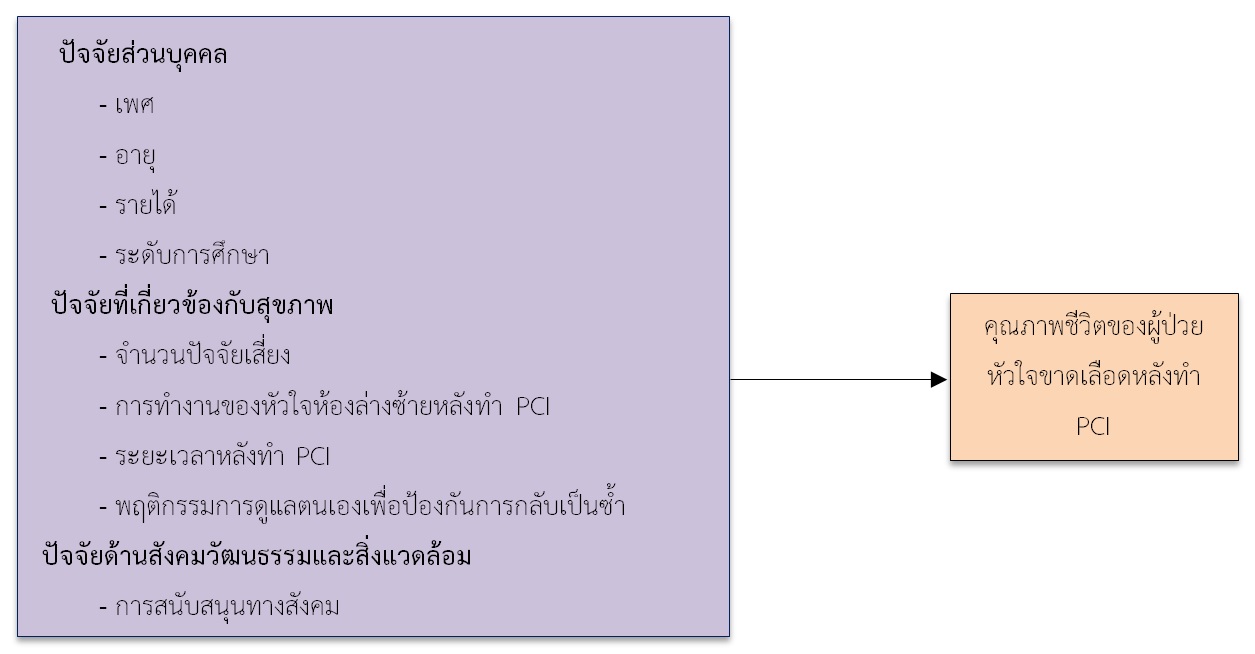ปัจจัยทำนายคุณภาพชีวิตผู้ป่วยหลังการรักษาด้วยการขยายหลอดเลือดหัวใจ อำเภอศรีราชา จังหวัดชลบุรี
คำสำคัญ:
คุณภาพชีวิต, โรคหัวใจขาดเลือด, ผู้ป่วยหลังได้รับการขยายหลอดเลือดหัวใจบทคัดย่อ
การวิจัยเชิงทำนายนี้มีวัตถุประสงค์เพื่อศึกษาคุณภาพชีวิตและปัจจัยทำนายคุณภาพชีวิตผู้ป่วยหลังการรักษาด้วยการขยายหลอดเลือดหัวใจ จำนวน 270 คน ใช้วิธีสุ่มอย่างง่าย เก็บรวบรวมข้อมูลในช่วงเดือนกรกฎาคม ถึงเดือนตุลาคม พ.ศ. 2563 เครื่องมือที่ใช้ประกอบด้วย แบบสัมภาษณ์ข้อมูลส่วนบุคคลและข้อมูลจากเวชระเบียนผู้ป่วย แบบประเมินคุณภาพชีวิต The European Quality of Life Measure-5 Domain (EQ- 5D- 5L) พฤติกรรมในการดูแลตนเองเพื่อป้องกันการกลับเป็นซ้ำ แรงสนับสนุนทางสังคม และ สิ่งแวดล้อมในชุมชนที่เอื้อต่อการส่งเสริมสุขภาพ โดยมีค่าความเชื่อมั่นเท่ากับ .73 0.96 และ 0.94 ตามลำดับ วิเคราะห์ข้อมูลด้วยสถิติเชิงพรรณนา และสถิติการวิเคราะห์การถดถอยพหุคูณแบบขั้นตอน ผลการวิจัยพบว่า
ระดับคุณภาพชีวิตของผู้ป่วยโรคหัวใจขาดเลือดหลังการรักษาด้วยการขยายหลอดเลือดหัวใจเมื่อประเมินจากแบบประเมิน EQ-5D-5L อยู่ในระดับที่สูงมาก ค่าเฉลี่ยอรรถประโยชน์ เท่ากับ .97 (SD=.06) ในขณะที่การประเมินคุณภาพชีวิตโดยตรงด้วยวิธีประเมินภาวะสุขภาพทางตรง (Visual analog scale [VAS]) ค่าเฉลี่ยเท่ากับ 76.96 (SD=14.16) โดยปัจจัยที่สามารถทำนายคุณภาพชีวิตผู้ป่วยโรคหัวใจขาดเลือดหลังการรักษาด้วยการขยายหลอดเลือดหัวใจได้แก่ การทำงานของหัวใจห้องล่างซ้ายหลังทำการขยายหลอดเลือดหัวใจ (b=0.298, p<.01) เพศชาย (b=9.859, p<.01) พฤติกรรมการดูแลตนเองเพื่อป้องกันการกลับเป็นซ้ำ (b=0.189, p=.012) สิ่งแวดล้อมในชุมชนที่เอื้อต่อการส่งเสริมสุขภาพ (b=0.296, p=.008) จำนวนปัจจัยเสี่ยง (b=-1.974, p=.017) และระยะเวลาหลังทำการขยายหลอดเลือดหัวใจ (b=0.574, p=.022) สามารถร่วมกันทำนายคุณภาพชีวิตได้ร้อยละ 22.1 (R2=.221, p= <001)
ผลจากการวิจัยนี้เสนอแนะว่าพยาบาลวิชาชีพ หรือบุคลากรทางการแพทย์ควรเพิ่มความระมัดระวังในการดูแลผู้ป่วยเพศหญิง ผู้ป่วยที่มีความสามารถในการบีบตัวของหัวใจต่ำ ผู้ป่วยที่มีปัจจัยเสี่ยงหรือโรคร่วมหลายโรค และผู้ป่วยที่ได้รับการทำการขยายหลอดเลือดหัวใจมาไม่นาน ควรเพิ่มความรู้ความเข้าใจและทักษะในการดูแลตนเองให้กับผู้ป่วยและญาติ และควรส่งต่อพยาบาลชุมชนในการดูแลผู้ป่วยอย่างต่อเนื่องเพื่อส่งเสริมคุณภาพชีวิตที่ดีให้กับผู้ป่วย
เอกสารอ้างอิง
Campbell, A., Converse, P. E., & Rodgers, W. L. (1976). The quality of American life: Perceptions, Evaluations, and Satisfactions: Russell: Sage.
Cassar, S., & Baldacchino, D. R. (2012 a). Quality of Life After Percutaneous Coronary Intervention: Part 1. British Journal of Nursing, 21(16), 965-971.
Cobb, S. (1976). Social Support as a Moderator of Life Stress. Psychosomatic Medicine, 38(5), 300-314.
Chansiri, K. (2016) The Relationship Between Basic Conditioning Factors, Self-Care Behaviors, and Quality of Life among Patients After Coronary Stent Implantation. Vajira Nursing Journal, 18(1), 12-23. (in Thai)
Charoenpattanaphak, P., Masingboon, K., Kunsongkeit, W. (2013) Factors Influencing Health - Related Quality of Life in Patients with Acute Myocardial Infarction. Journal of Gradurate Research Conference Khon Kaen University 2013, 1008-1020. (in Thai)
Chaykhetkaew, U. (2009) Health Technology Assessment Guide for Thailand. Nonthaburi: Chulabook. (in Thai)
Cohen, D. J., Van Hout, B., Serruys, P. W., Mohr, F. W., Macaya, C., den Heijer, P., et al. (2011). Quality of Life After PCI with Drug-Eluting Stents or Coronary-Artery Bypass Surgery. New England Journal of Medicine, 364(11), 1016-1026. doi: 10.1056/NEJMoa1001508
Darvishpour, A., Javadi-Pashaki, N., Salari, A., Sadeghi, T., & Taleshan-Nejad, M. (2017). Factors Associated with Quality of Life in Patients Undergoing Coronary Angioplasty. Journal of Health Sciences (Qassim University), 11(4), 1-7.
Huffman, J. C., Celano, C. M., & Januzzi, J. L. (2010). The Relationship Between Depression, Anxiety, and Cardiovascular Outcomes in Patients with Acute Coronary Syndromes. Neuropsychiatric Disease and treatment, 6, 123.
Jankowska-Polanska, B., Uchmanowicz, I., Dudek, K., & Loboz-Grudzien, K. (2020). Sex differences in the Quality of Life of Patients with Acute Coronary Syndrome Treated with Percutaneous Coronary Intervention After a 3-Year Follow-Up. Patient Preference and Adherence, 10, 1279-1287. doi: 10.2147/PPA.S106577
Koh, Y., Stehli, J., Martin, C., Brennan, A., Dinh, D. T., Lefkovits, J., et al. (2019). Does Sex Predict Quality of Life After Acute Coronary Syndromes: An Australian, State-Wide, Multicentre Prospective Cohort Study. BMJ Open, 9(12), e034034. doi: 10.1136/ bmjopen-2019-034034
National Statistical Office. (2019) Number of Patients/Cause of Death. Retrieved from http://service.nso.go.th/nso/web/statseries/statseries09.html (in Thai)
Pattanaphesaj, J. (2014). Health-Related Quality of Life Measure (EQ-5D-5L): Measurement Property Testing and Its Preference-Based Score in Thai pPopulation. Doctoral Dissertation, Geaduate Study, Mahidol University.
Ritpetch, N., Jitpanya, C. (2012) Factors Related to Quality of Life among Patienta with Heart Disease : A Research Synthesis in Thailand. Thai Journal of Cardio-thoracic Nursing, 23(2), 1-16. (in Thai)
Saengsiri, A., Wattradul, D., Kangchanakul, S., Natthumrongkul, S., Nopplub, S., Wonganunnont, S. (2015) The Factors Inuencing the Self-care Agency and Quality of Life of Patients with Coronary Artery Disease. Thai Journal of Cardio-thoracic Nursing, 26(1), 104-118. (in Thai)
VanVoorhis, C. W., & Morgan, B. L. (2007). Understanding Power and Rules of Thumb for Determining Sample Sizes. Tutorials in Quantitative Methods for Psychology, 3(2), 43-50.
World Health Organization. (2018). The Top 10 Causes of Death. Retrieved May 2, 2021 from http://www.who.int/healthinfo/global_burden_disease/estimates/en/.
World Health Organizaion EUROPY. (1986). Ottawa Charter for Health Promotion. Retrieved May 2, 2021 from https://intranet.euro.who.int/_data/assets/pdf_file/0004/129532/Ottawa_ Charter.pdf
Zhan, L. (1992). Quality of Life: Conceptual and Measurement Issues. Journal of Advanced Nursing, 17, 795-800.

ดาวน์โหลด
เผยแพร่แล้ว
ฉบับ
ประเภทบทความ
สัญญาอนุญาต
ลิขสิทธิ์ (c) 2022 วารสารการพยาบาลและการศึกษา

อนุญาตภายใต้เงื่อนไข Creative Commons Attribution-NonCommercial-NoDerivatives 4.0 International License.





